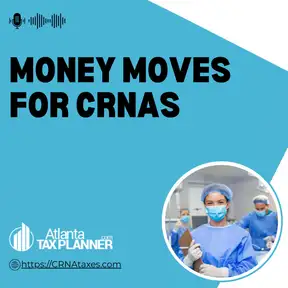Tax-Free CRNA Money in Retirement? Yes, Please.
Download MP3Hi. This is Money Moves for CRNAs, a two times per month podcast made just for 1099s like you. We talk about taxes, smart planning, and how to grow your money, all in simple short episodes. Just remember, these tips are educational and general in nature. For help with your own money plan, chat with a tax or financial adviser.
Bill White:Here's your host, Randy Larkin of Atlanta Tax Planner.
Randy Larkin:Hi there. For the next three podcasts we're going to be talking about Roth IRAs. Today we'll cover the basics, what it is and how it works. In the next episode we'll talk about something called the backdoor Roth IRA And in the last one, we'll show how 1099 CRNAs are using these retirement accounts to plan for their future. Now I know, a Roth IRA sounds like something you need a calculator to understand.
Randy Larkin:But nope, we're gonna make it easy. So grab a coffee and let's go. What even is a Roth IRA? Okay, let's start at the beginning. A Roth IRA is a special savings account.
Randy Larkin:You put in money now and when you retire someday you can take that money out and all the extra money it made over the years without paying any taxes on it. It sounds like magic. Right? But here's the thing, not everyone is allowed to use a Roth IRA. So let's look at the rules.
Randy Larkin:Rule number one. How much money you make matters. The government sets a rule based on your income. They use what they call your modified adjusted gross income. MAGI for short. Using your MAGI, here's what the IRS says for 2025.
Randy Larkin:If you're single and make less than a $150,000 per year, you can put in the full amount. If you make between a 150 and a 165,000, you can put in some money but not the full amount. Over a 165,000? Sorry. You can't contribute directly to a Roth IRA.
Randy Larkin:If you're married and file taxes together, the limit jumps to 236,000 to 246,000. So it depends on how much you earn and whether you're filing taxes alone or with someone else. Rule number two: How much can you put in? Let's say you are allowed to use a Roth IRA. How much can you put in?
Randy Larkin:If you're under age 50, the limit is $7,000 per year. If you're 50 or older, you get to put in an extra $1,000. This is called a catch up contribution for a total of $8,000. It's like saying, I'm getting closer to retirement. Let me save a little extra.
Randy Larkin:Rule number three, you have to have a job. You can only put money in if you have earned income. That means money from a job, like a salary, hourly pay, or money you make from your own business. What doesn't count? Investment income, like money from stocks or rental property.
Randy Larkin:That won't do it. You need to actually work for the money. Rule number four. No age limit. Here's the nice part.
Randy Larkin:You can be 20 years old or 80 years old. If you have earned income you can put money into a Roth IRA. So grandma and grandpa with part time jobs? Yep. They can still contribute.
Randy Larkin:Age doesn't kick you out. How nice is that? Rule number five. Deadlines matter. You have until tax day to put in your contribution for the previous year.
Randy Larkin:That's usually April 15 of the following year. So if it's still early in the New Year and you forgot to contribute for last year, there's still time. Rule number six Spousal contributions. Okay, this is really nice. If you're married and only one of you works, the non working spouse could still put money into a Roth IRA as long as the working spouse earns enough to cover both contributions.
Randy Larkin:So it's a great way for couples to save together. Bonus tip. No required withdrawals. Most retirement accounts make you start taking money out once you reach your seventies. But with the Roth IRA, nope.
Randy Larkin:You can just let it sit and grow forever if you want. Recap Time. Let's break it down. You can only use a Roth IRA if your income is under the limit. The most you can put in is $7,000 or 8,000 if you're 50 or above.
Randy Larkin:You need earned income from a job. You can contribute at any age. You have until tax day to contribute. Your nonworking spouse can contribute if you file taxes together. And you don't ever have to take the money out if you don't want to.
Randy Larkin:That's a lot of good stuff packed into one retirement account. So that's the Roth IRA, a little account with big potential. Next time, we'll talk about what to do if you make too much money to use a Roth IRA. Spoiler alert. There's a backdoor.
Bill White:Alright, friends. That wraps up today's show. We hope you learned something new. Head over to crnataxes.com if you want to learn how we help other 1099 CRNA's. Our next episode is all about the backdoor Roth IRA. Take care.
Bill White:Music licensed from premiumbeat.com under license number 7394047.

